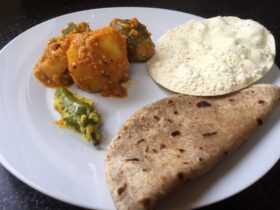Being of Indian origin, I grew up eating primarily Indian (specifically Gujarati) food. So, when I was diagnosed with Crohn’s disease, my diet changed entirely. It became boring and unexciting. After deciding this just won’t do, my mother, grandmother and I started to experiment with different recipes and ways of cooking Indian food. After 14 years of trial and improvement, we have perfected a number of different cooking techniques and formulas to make a South Asian diet suitable for Crohn’s sufferers / those with an ostomy. NB: what suits one person may not work for another so, as with all diets, it is important to try carefully for yourself.
Chapattis (rotli/roti)
This is perhaps the most important constituent of a South Asian diet, so I made sure I tried out different types of chapatti flour very early on in my life as an ostomate. My grandmother normally makes chapattis using wholemeal flour with extra bran added in but these are especially difficult for me to digest now, due to the high fibre content. Number 1 and number 2 type chapatti flour is least fibrous and, therefore, the easiest to digest. I personally prefer number 2 because it’s a mixture of wholemeal and white flour and (according to my IBD (Inflammatory Bowel Disease) nurse) still has a decent iron content.
Legumes
Mong bean dishes, bean curries and various types of daal are often an important source of protein in a South Asian diet, especially for those who are vegetarian. I cook all of my legumes until they are nice and soft because I find that those which are not quite cooked enough or dry legume dishes (i.e. not soupy) do not pass through my stoma very easily. I use a pressure cooker to get my legumes soft enough. Well, actually, my mum does this for me because I’m a fully grown adult who is still scared of the pressure cooker ...we all have our flaws!
Meat
Chicken and fish dishes don’t pose any problem at all in terms of my stoma. With lamb, which can sometimes be quite tough, again it’s a good idea to use a pressure cooker. Also, young lamb is more tender than mutton so is more digestion friendly. Cooking the lamb with yoghurt can help to keep it tender too.
Vegetables
There are some vegetables, such as carrots, aubergine and spinach which do not pose any problem to me whatsoever so long as they are soft. For vegetable curries such as gourd (doohi, gilora, tindora, karela), green beans and cauliflower, I bust out my trusty pressure cooker. Thoroughly cooked vegetables equal a happy tummy.
Rice
Rice is my go to food on the days when I’m feeling particularly unwell. I use white rice - again to reduce the fibre content - and eat it with a soupy dish such as daal. One of my favourite foods is the ayurvedic powerhouse, khichri; it’s a light and simple dish consisting of rice, split lentils and spices.
Spices
I personally do not use chilli or chilli powder in my curries at all as it worsens my Crohn’s symptoms. When I go to someone’s house and they say “I knew you were coming so I made the curry extra mild today”, it really melts my heart. I still use all the other South Asian spices (turmeric, cumin, coriander powder, cloves, cinnamon, cardamom, mustard seeds, carom seeds, asafoetida) so that the dish has an Indian flavour, minus the heat.
Do not underestimate the importance of matching particular spices with certain foods. I would not advise a ‘one curry paste fits all’ policy for ostomates, or for those with digestive disorders. In South Asian cookery, many spices have a medicinal function as well as a role to play on the taste buds. For example, a tiny pinch of asafoetida or carom seeds is added to legume dishes to reduce the amount of gas production.
Final tips
A final note on flavours – many Indian dishes include coconut but, as it doesn’t digest well at all, it’s not exactly ostomate-friendly. Instead, I use coconut milk. You still get that rich and creamy flavour but without the stomach ache. Similarly, I substitute nuts for either smooth peanut butter, almond butter or cashew butter.
I’m sure you’ve guessed by now that our pressure cooker is invaluable to me. If you are going to use one yourself, please be careful and follow proper instructions as they can be dangerous if handled incorrectly.
What are your cooking tips and tricks for an ostomy friendly diet? I’m always eager to hear some new ideas!

Article by Rakhee Patel
About the author
I'm Rakhee, I have had a loop ileostomy and now have an end ileostomy due to Crohn's disease. Happy to share my journey!
